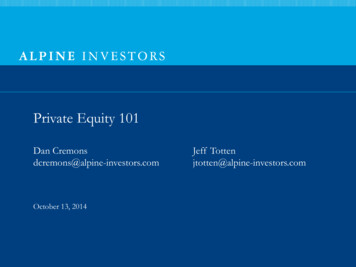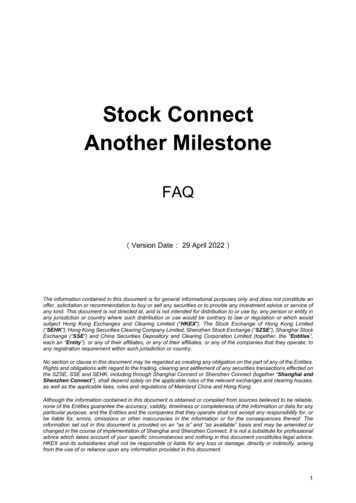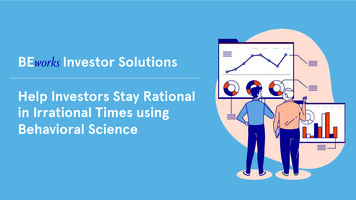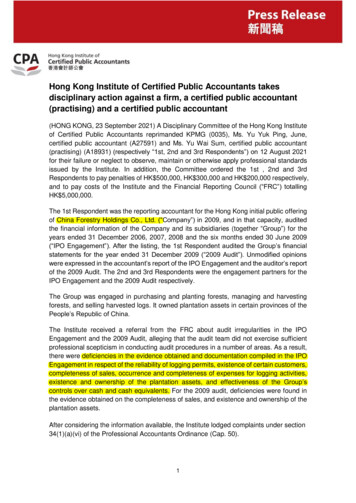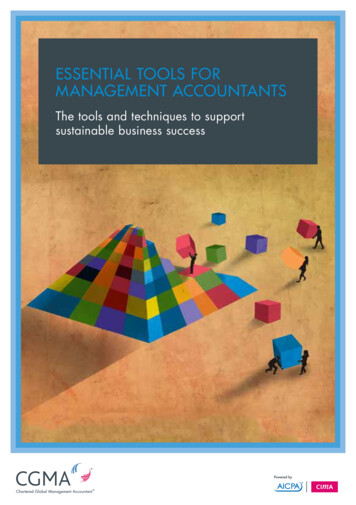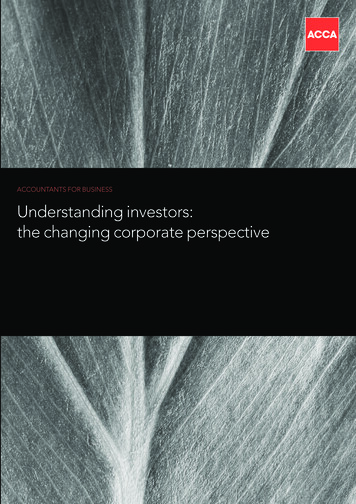
Transcription
ACCOUNTANTS FOR BUSINESSUnderstanding investors:the changing corporate perspective
About ACCAACCA (the Association of Chartered CertifiedAccountants) is the global body for professionalaccountants. We aim to offer business-relevant, firstchoice qualifications to people of application, ability andambition around the world who seek a rewarding careerin accountancy, finance and management.Founded in 1904, ACCA has consistently held uniquecore values: opportunity, diversity, innovation, integrityand accountability. We believe that accountants bringvalue to economies in all stages of development. We aimto develop capacity in the profession and encourage theadoption of consistent global standards. Our values arealigned to the needs of employers in all sectors and weensure that, through our qualifications, we prepareaccountants for business. We work to open up theprofession to people of all backgrounds and removeartificial barriers to entry, ensuring that our qualificationsand their delivery meet the diverse needs of traineeprofessionals and their employers.We support our 162,000 members and 428,000 studentsin 173 countries, helping them to develop successfulcareers in accounting and business, with the skills neededby employers. We work through a network of over 89offices and centres and more than 8,500 ApprovedEmployers worldwide, who provide high standards ofemployee learning and development.ABOUT ACCOUNTANTS FOR BUSINESSACCA’s global programme, Accountants for Business,champions the role of finance professionals in all sectorsas true value creators in organisations. Through people,process and professionalism, accountants are central togreat performance. They shape business strategy througha deep understanding of financial drivers and seekopportunities for long-term success. By focusing on thecritical role professional accountants play in economies atall stages of development around the world, and indiverse organisations, ACCA seeks to highlight andenhance the role the accountancy profession plays insupporting a healthy global economy.www.accaglobal.com/ri The Association of Chartered Certified Accountants,February 2014This report is the last in a four-partseries examining what investorswant from corporate reporting andhow organisations are respondingto their needs.It examines current trends inreporting and the auditrelationship from the perspectiveof the CFO, with a particularemphasis on real-time andintegrated reporting.
ContentsForeword4Executive summary51. Speed of external reporting82. Speed of internal reporting123. Fast, faster, real time?134. Barriers to real-time reporting155. Integrated reporting186. Competition and fees in the audit relationship207. Conclusion21References22UNDERSTANDING INVESTORS: THE CHANGING CORPORATE PERSPECTIVE3
ForewordACCA has consistently argued that the role and interests of investors needto be better understood and placed more centrally in policymakingprocesses by legislators and standard setters. The investor’s voice is oftennot heard strongly enough, which is perhaps understandable given therange of organisations and interests that can fall under the heading of‘investors’.In order to address this need for greater understanding of the investorlandscape, ACCA, in collaboration with Longitude Research, developed afour-stage project examining the changing investor universe since the globalfinancial crisis, and what investors want from corporate reporting. Theproject examined how pressure to respond to the needs of investors maychange the approach taken by companies in reporting their activities andengaging investor groups.Over the four stages, the project examined: recent developments in the investor landscape, trends and emergingissues since the global financial crisis the kind of information investors need to make their decisions, how theynow like to receive that information (both the format and thecommunications channel), and their level of trust in what they receive the move towards ‘real-time’ reporting, and how companies areresponding to calls to disclose certain information with much moreimmediacy, rather than at the end of a quarter or year how companies are already changing their investor engagement andreporting activities to reflect evolving investor demands, and what thismeans for the finance function and the chief financial officer.Helen BrandACCA chief executiveThis report is the fourth stage of that process. Although it uses the UK andIreland-based CFOs investor base for its analysis, the trends it identifies havea much wider resonance, internationally.4UNDERSTANDING INVESTORS: THE CHANGING CORPORATE PERSPECTIVE
Executive summaryABOUT THE RESEARCHThis report, which was written byLongitude Research on behalf of ACCA,is based on a survey of 200 CFOs andother senior finance professionals,conducted in October 2013, and aprogramme of in-depth interviews withleading figures from the corporatefinance community.Around half the respondentsrepresented companies with annualrevenues in excess of US 500 million.There was a good spread acrosssectors, including automotive,consumer products, financial services,media and entertainment, oil and gas,and technology. Respondents were splitbetween the UK and Ireland, with 80%in the former, and 20% in the latter.ACCA would like to thank everyone whotook part in the research.IN-DEPTH INTERVIEWSIn particular, ACCA would like to thank the following, who provided in-depth interviews with the research team.Holly Birch, head of investor relations, The Go-Ahead GroupStephen Burrows, head of financial reporting and investor relations, Great Portland EstatesTony Cates, head of audit, KPMGAndy Chard, director of financial reporting, AstraZenecaAndy Davies, partner, EYBob Dohrer, global leader for quality and risk, RSM InternationalAndy Moss, finance director, Phoenix LifeRoss Paterson, finance director, Stagecoach GroupSusan Robertson, chief financial officer, VelocysAnkita Tyagi, research analyst, Aberdeen GroupUNDERSTANDING INVESTORS: THE CHANGING CORPORATE PERSPECTIVE5
THE KEY FINDINGSThe speed with which companiesrelease their annual accounts is seen asan important indicator of efficientmanagement and good governance.Almost two-thirds of CFOs say thatexternal stakeholders see a speedyclose as a sign of good management. Amajority of CFOs have already madeefforts to close their accounts morequickly, and most intend to reduceclosing times further over the next threeyears. A broad majority of respondentsbelieve that faster closing has not onlyimproved their reporting culture, but ithas also led to better decision makingin the corporate reporting cycle.Moreover, the reduction in closing timehas allowed companies to re-allocateimportant resources in their financedepartments to make them moreefficient.There is cautious support for a move toreal-time reporting. Two-thirds of CFOssurveyed would welcome a movetowards greater adoption of real-timereporting, but they also worry that thiscould compromise competitionsensitive information and lead tomisstatements. In addition, 45% ofrespondents said that the difficulty ofinstituting effective controls to ensureaccuracy is a major obstacle to morewidespread use of real-time financialreporting.6Within three years, nearly half thecompanies surveyed could have movedto an integrated reporting model.Around 40% of the companies surveyedare either taking active steps to movetowards an integrated reporting model,or have already implemented one. Theothers are adopting a ‘wait and see’approach or, in the case of 10%, haveno intention of making the move unlessit is compulsory. CFOs consider that themain benefit of integrated reporting isthe ability to present the company as anadvocate of sustainability, but manyalso say that it would help them to alignthe company’s risks with itsopportunities, adopt a more holisticview of the true drivers of corporateperformance, and build betterrelationships with external stakeholders.Companies with an emphasis onlonger-term investors are especiallylikely to see implementing integratedreporting as a priority.Relations between companies and theirauditors are generally good but there isroom for improvement. Asked how theaudit profession could improve,respondents point to lower fees andgreater competition as key preferences.Nonetheless, interviews with CFOspaint a more nuanced picture. WhileCFOs, in general, are understandablykeen to reduce costs where possible,many of those interviewed for thisreport make the connection betweenprice and quality of service: they do notwant the quality of an audit to suffer iffees fall.THE CHALLENGES AHEADThe survey reveals a number of findingsthat should be examined by CFOs andother senior finance professionals. Thekey challenges that they will need toconsider over the next few years includethe following.Speeding up the internal reportingprocessMany companies have already takensteps to secure ‘real-time’ informationwithin the business, but others still haveconsiderable work to do. Up-to-theminute information about keyperformance metrics is a vital source ofcompetitive advantage, because ithelps companies to become more agile,meaning they can respond more quicklyto market changes.Focusing on the accuracy andintegrity of dataReal-time information within a businessonly has value if executives can haveconfidence in the underlying data.Accessing accurate, complete data is amajor challenge, particularly incompanies where data is distributedwidely across multiple applications andsilos. Making data more consistent,standardised and accurate remains akey goal for many companies.UNDERSTANDING INVESTORS: THE CHANGING CORPORATE PERSPECTIVE
Accelerating the external reportingprocessThis research has shown that investorsand other external stakeholders placesignificant value on the speed withwhich a company is able to releaseaudited financial information. Becauseinvestors see a faster close as a proxy ofgood corporate governance andmanagement, companies that canrelease information quickly will have anadvantage in attracting investment. Itcan also help to strengthen reputation.Balancing speed with assuranceInvestors value more frequent, rapidreporting and CFOs are, for the mostpart, supportive of this trend.Nonetheless, care must be taken tostrike a balance between speed and theneed for assurance. Releasinginformation quickly has no benefit if thatinformation is subsequently found to besubject to misstatements or reportingerrors.Considering carefully the pros andcons of more frequent reportingInvestors have signalled that they wantcompanies to report more frequently,and that they will reward companiesthat do this, but the downsides of morefrequent reporting also need to beconsidered. In particular, numerousstudies – such as The Kay Review of UKEquity Markets and Long-term DecisionMaking, for instance – have shown thatquarterly reporting leads to shorttermism and volatility in financialmarkets. Care must be taken – at apolicy level as well as among corporates– that the benefits of more frequentreporting are not outweighed by thedisadvantages.Preparing for integrated reportingThe research has found strong supportfor integrated reporting amonginvestors. Most of the CFO respondentsalso indicate that they will ultimatelymove towards this model. There is,however, some reluctance amongcompanies to be a first mover. Althoughpolicymakers need to do more toeducate and engage corporates in thebenefits of integrated reporting, CFOsthemselves should develop a betterunderstanding so that they candetermine the right time to make thetransition.UNDERSTANDING INVESTORS: THE CHANGING CORPORATE PERSPECTIVE7
1. Speed of external reportingThe pace at which information becomesavailable continues to accelerate at abewildering rate. News stories thatonce may have taken a day or more tobecome widely known are nowtransmitted instantly around the worldvia social media and other channels.Business intelligence tools now givecompanies the ability to make decisionson the basis of up-to-the-minutecustomer data. In the world of financialmarkets, things move so rapidly thattrading decisions using algorithms arenow made in a matter of milliseconds.Given the speed of these informationflows, it seems somewhat incongruousthat, for most investors, the key auditedsource of information about a companyis a report that is published only once ayear. Not only that, but the gap betweenthe time when a company closes its booksand releases an annual report can be eightweeks or more. In a world of highfrequency trading and 24/7 businessnews, that can seem like a lifetime.Yet, despite this timing mismatch,investors remain deeply wedded to theannual report. As ACCA highlighted inits recent report UnderstandingInvestors: Directions for CorporateReporting, investors point to the annualreport as the most valuable source ofinput for making investment decisions,by a considerable margin. Informationand markets may now move at the speedof light, but the annual report remains avital part of the investor toolkit.There is, however, growing demandamong investors for annual reports tobe published more quickly. In the sameACCA survey, just 51% of investors saidthat they are satisfied with thetimeliness of company information.More importantly, from the perspectiveof the CFO, investors make cleardistinctions between companies thatthey regard as reporting quickly andefficiently, and those that they believedo not. In another report in this series,Understanding Investors: The Road toReal-time Reporting, 70% of investorsFigure 1.1: What do you see as the biggest benefits of a ‘faster close’ in the corporate reporting cycle?010%20%30%40%50%60%A culture of faster external reporting willalso benefit internal management reportingand information, leading to better decisions72External stakeholders will see a faster closeas a proxy of good management andgovernance at the company63A faster close instils confidence in regulatorsthat the reporting process is efficient andeffectiveA more efficient process will reduce reportingand compliance costsA faster close instils confidence in investors,and helps to attract investment to the company870%524948UNDERSTANDING INVESTORS: THE CHANGING CORPORATE PERSPECTIVE
said that companies reporting in realtime would have an advantage inattracting investment, and 73% wouldconsider that companies that report inreal time have more robust corporategovernance.Broadly speaking, CFOs agree with thissentiment among their investor baseand recognise that a faster close willyield advantages. Almost two out ofthree CFO respondents think that a keybenefit of a faster close is that externalstakeholders see it as a sign of goodmanagement; and more than half find itbeneficial that a rapid reporting ratealso instils confidence in regulators (seeFigure 1.1). This suggests that manyfinance professionals have an appetiteto accelerate the closing process inresponse to growing investor andstakeholder demand.A faster close also benefits companiesbecause it facilitates a more efficientuse of scarce resources. Andy Chard,director of financial reporting atAstraZeneca, which has prioritised fastclosing of accounts for some time,points out that a reduction in the timeto close has had this effect: ‘By closingfaster, we can free up resources in ourfinance department, and they can moveon to other important priorities.’Indeed, there is now such an emphasis onspeed that many finance leaders considerit more important than assurance.Among our respondents, less thanone-third of CFOs agree that assuranceis more important than speed when itcomes to communicating financialinformation to external stakeholders.Tony Cates, head of audit at KPMG,notes that there is a trend for somecompanies to release unaudited figuresat year-end, but he adds that this onlyworks if companies are highly confidentthat their numbers are correct.The survey finds that a majority ofcompanies are taking steps toaccelerate the closing process. Morethan 7 in 10 respondents say that fasterclosing is a priority for their business(see Figure 1.2). Over the past threeyears, almost 3 out of 5 respondentsFigure 1.2: How much of a priority are the following reporting initiatives in your business?010%Faster closing of corporate reports30%40%26Strengthening links between reported KPIs and strategic goals19Rethinking distribution of annual reports(eg via online or social media)18Implementing integrated reporting20%17Strengthening narrative reporting161Top priorityUNDERSTANDING INVESTORS: THE CHANGING CORPORATE %52930280%233414Rethinking formats of annual reports (eg interactive)50%45Not a priorityat all9
have already made significantreductions in the time it takes to publishtheir annual report following year-end.A further 28% have moderatelyincreased their reporting speed overthis period (see Figure 1.3). Over thenext three years, companies want toreduce the amount of time to close theirbooks from an average of 51 to 45 days.have predominantly long-term investorsto have accelerated the externalreporting process. They are also morelikely to perceive pressure fromshareholders for a faster close and tothink that external stakeholders will seea faster close as a sign of goodmanagement and governance.The extent to which companies arefocusing on a faster close, however,depends on a variety of factors,including investor profile. For example,those respondents who say that theyhave a higher proportion of short-terminvestors are more likely than those thatFigure 1.3: Over the past three years, what changes have you made to the following aspects of your company’s corporate reporting?010%20%Speed of the external corporate reporting processSpeed of the internal corporate reporting ment in headcount to support reporting capabilitiesUse and adoption of XBRL and other technologies40%58Investment in data and infrastructure to support reportingcapabilitiesFrequency of the external corporate reporting process30%45SignificantdecreaseUNDERSTANDING INVESTORS: THE CHANGING CORPORATE PERSPECTIVE
FAST CLOSING AT ASTRAZENECAThe pharmaceuticals company AstraZeneca has long had an emphasis onfaster closing. The company currently runs an eight-day reporting andconsolidation process to close its books. Andy Chard, director of financialreporting at AstraZeneca, believes this is important for many reasons. Firstand foremost, it provides faster information for internal and externalstakeholders. It also releases finance department staff to focus on other areasof the business. ‘Faster reporting allows the finance team to move on to othermatters more quickly, such as acting as a business partner,’ he says. ‘I think italso provides benefits to the company in terms of reputation.’To achieve a faster close, the company has made a number of changes. A keyfactor has been to make local business units responsible for their figures. ‘Aspart of our process to speed up closing, local CFOs can’t submit theirnumbers until their intercompany reconciliations are complete, so it becomespart of their process rather than our process,’ says Chard. ‘Holding the localCFOs to account for their numbers took a lot of heat out of our consolidationprocess – it was a big step forward for us.’Chard also emphasises the importance of governance. ‘We run a highlycentralised approach to drive timelines and policy, and that is key to closingquickly. It’s about identifying the significant transactions early, andcoordinating the timetables and policies with a high degree of control andaccountability. This kind of centralised policy is a key part of the culture atAstraZeneca.’A fast close also depends on an effective relationship with auditors. ‘If wecomplete a business acquisition mid-month, we will involve our auditorsalmost immediately,’ says Chard. ‘There is a high degree of interaction, andit’s iterative in terms of their involvement throughout the year. And, as we runa centralised policy framework, they can plan their work according to thesepredetermined rules.’UNDERSTANDING INVESTORS: THE CHANGING CORPORATE PERSPECTIVE11
2. Speed of internal reportingAchieving a faster close requirescompanies to have a strong internalreporting framework in place. Thisdepends on a combination ofingredients, including robusttechnology infrastructure, the ability tocollect, standardise and aggregate dataquickly, good governance and stronginternal processes. Quicker internalreporting brings with it a variety ofbenefits – some of which are outlined inthe CFO Research Service reportAccelerating the Financial Close: CFOs’Insights into the Benefits of a HighQuality Close – including the ability tomake decisions more quickly, and theability to consider figures fully beforereleasing them to the market.Among the respondents, there seemsto be an appetite to make thesechanges, despite a cost-consciousenvironment in which it remains difficultfor companies to justify new projectsand initiatives. For example, a majorityof respondents report increasedinvestment in data and infrastructure tosupport reporting capabilities (seeFigure 1.3), and 47% are investing inheadcount to support reportingcapabilities.Ross Paterson, finance director atStagecoach Group, argues that a focuson internal processes has been a keydriver of accelerating internal reportingat his company. ‘In the past three years,internal processes have become tighterbecause the board and auditcommittee have wanted more time tosee and understand the results. Thatmeans that, if they feel any changes arerequired, they have time to reflect on itbefore it goes to the market,’ he says.There are clear signs from the surveythat companies with a slow externalreporting process are taking steps toaddress the internal reportingcapabilities that will enable fasterexternal closing. Companies thatcurrently take more than seven weeks toclose their books have a particular focuson strengthening their internalreporting capabilities (see Figure 2.1).Those with a faster external close, bycontrast, focus less on speeding upinternal processes, probably becausethese changes have already been made.‘You need to speed up your internalprocesses before you can begin toconsider speeding up externalprocesses,’ says Cates.Figure 2.1 : Over the past three years, what changes have you made to the speed of the internal corporate reporting process?0Companies closing in less than seven weeksCompanies closing in more than seven ERSTANDING INVESTORS: THE CHANGING CORPORATE PERSPECTIVE
3. Fast, faster, real time?Many companies are increasingly ableto access real-time data to influencedecision making (Aberdeen Group2012). Dashboards and othertechnologies can offer senior executivesa constant flow of up-to-the-minuteinformation on the cash position, salesand key risk exposures. In addition topresenting these high-level metrics,many business intelligence tools willenable executives to ‘drill down’ andaccess highly granular information –sometimes down to a transaction level.Many of the respondents already havepockets of real-time information withintheir business. Just over half say theircurrent cash flow figures aredisseminated internally in real time; 42%can get instant profitability data and47% can access accounts payable andreceivable by the minute (see Figure3.1). Ankita Tyagi, research analyst,Aberdeen Group, notes that researchsuggests that finance departments arenow seeking real-time information for awide variety of tasks, including cashflow and price monitoring, riskmanagement, financial planning,back-office functions, accounts payableand receivable, and payroll (FinancialDirector 2011).While real-time information is availablewithin a business, possibly on a minuteby-minute basis, investors have to makedo with annual, biannual or quarterlyreporting.There are signs that this discrepancy isno longer sustainable. As ACCA foundin its recent report in this series,Understanding Investors: The Road toReal-time Reporting, investors have astrong appetite for real-time reporting,whereby companies provideinformation on an as-needed basisinstead of only at pre-determinedintervals (Aberdeen Group 2012). Theysay that an emphasis on real-timeinformation would improve theirunderstanding of corporateperformance, enable them to respondmore quickly to information, andenhance the returns they can achieve.So what do companies and investorsmean by real-time reporting? In reality,there is no single accepted definition of‘real time’. A recent survey showed thatthere are different interpretations of theconcept. Almost half of respondents(49%) view information that is updatedFigure 3.1: In which of the following areas would you say you currently have real-time financial information internally withinthe business?010%20%30%40%Cash flow60%70%51Accounts payable and les performanceTax position50%3113UNDERSTANDING INVESTORS: THE CHANGING CORPORATE PERSPECTIVE13
on a per-minute basis as real time. Aslight majority of respondents (51%)think data can still be considered realtime if it is updated less frequently: onan hourly or even a daily basis(Aberdeen Group 2012).It is not just investors who see benefitsin real-time reporting. The ACCA surveyalso finds strong support for theconcept among CFOs – although theydo have some concerns. Two-thirds ofCFOs say they would like to movetowards widespread real-timereporting, but they worry that it couldcompromise sensitive information, suchas sales figures, and could increase thechance that competitors will gainactionable intelligence (see Figure 3.2).‘You don’t want to disclose toomuch but you don’t want to disclose toolittle either, so you want to give peoplea sense of transparency withoutshowing all your cards,’ says Tyagi.Frequency of reporting is alsoinfluenced by a company’s sector —and by benchmarking against a peergroup of competitors and similarcompanies. “If you are apharmaceuticals company, then youneed to be coming out with the resultsroughly the same time as everyoneelse,” says Tony Cates.Figure 3.2: Which of the following statements best describes your perspective on the potential for companies to report financialinformation in ‘real-time’ (ie on-demand reporting rather than episodic at set intervals)?010%We would fully welcome a move towardsgreater provision of real-time financialinformation to align external reporting moreclosely with internal managementinformation40%50%60%70%67We support a move towards real-timereporting in some circumstances(eg reporting of material financial events),but are generally not in favour of it1430%13We would like to see a move towards greateradoption of real-time reporting, but worrythat this could compromise sensitivecompetitive information and lead tomisstatementsWe are firmly opposed to a shift towardsreal-time financial reporting20%156UNDERSTANDING INVESTORS: THE CHANGING CORPORATE PERSPECTIVE
4. Barriers to real-time reportingDespite the support for real-timereporting, it does present bothinvestors and companies with a numberof challenges. One key concern is that itcan lead to misstatements. Whileproper assurance is time-consumingand decreases the speed of informationflow, it does give stakeholdersconfidence that figures meetaccounting standards. Andy Davies, apartner at EY, says that today’s financialreporting demands a high degree ofjudgement. ‘As data reporting getsfaster and faster, there will be less timeto go through the necessary steps tomake sure it is presented correctly,’ henotes. Davies also contends thatclose-to-real-time information willalways be less accurate because it willnever adhere to current accountingstandards.CFOs surveyed for this report seeauditors as the biggest barrier toreal-time reporting, with 3 out of 5respondents saying that they arereluctant to speed up the reportingprocess (see Figure 4.1). But Mr Catesargues that technological tools nowallow auditors to work closely togetherwith clients to produce faster reporting.‘Strictly speaking, the auditing processdoes slow things down,’ he says. ‘But Ithink we as auditors are working closerwith companies so that they can doreal-time. We are developing new toolsthat will allow us to do this.’heavily dependent on the quality of thecompany’s internal controls, reportingmechanisms and structures,’ heobserves. ‘When those systems arequestionable, auditors need to usemore time-consuming, in-depth auditprocedures, and that drags out the timeframe under which assurance can beprovided.’The difficulty of putting in placeappropriate controls to ensure accuracyis also identified by 45% of respondentsas a key barrier preventing wideradoption of real-time financialreporting. More than a third ofrespondents are worried that real-timereporting would lead to premature‘estimates’ and believe a timelierprovision of corporate reportinginformation would be prohibited by thesheer volume of data.Bob Dohrer, global leader for qualityand risk at RSM International, urges ajoint effort between management andauditors. ‘I think auditors are makinghuge strides towards providinginformation more quickly, but they areFigure 4.1: What do you see as the biggest barriers to the ‘faster close’ and timelier provision of corporate reporting informationto external stakeholders?010%20%30%40%Reluctance of auditors to increase the speedof the process60%70%61Technology infrastructure prevents furtheracceleration4336Concerns that further acceleration couldaffect quality35The volume of data and information toprocess will not enable a faster close32Lack of human resourcesChallenges securing the quality of data forreporting24Reluctance of audit committee to increasethe speed of the process20Dependence on manual processes19The com
Equity Markets and Long-term Decision Making, for instance - have shown that quarterly reporting leads to short-termism and volatility in financial markets. Care must be taken - at a policy level as well as among corporates - that the benefits of more frequent reporting are not outweighed by the disadvantages.

